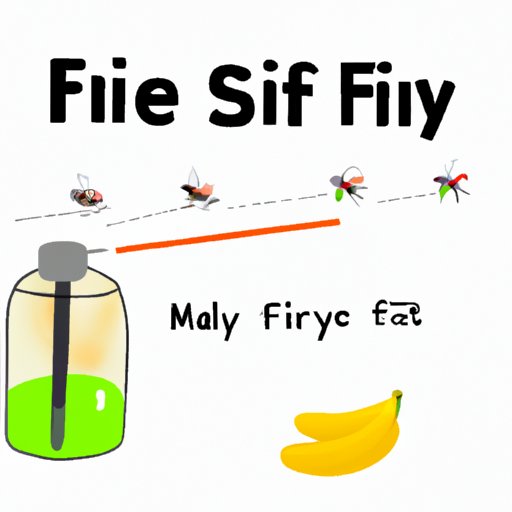
I. Introduction
Fruit fly infestations are an all-too-common problem in households around the world. These tiny pests are attracted to fruits and vegetables that are overripe or beginning to rot, and can quickly turn a kitchen into a nightmare. The good news is that there are plenty of quick remedies that can help you get rid of these pesky insects. In this article, we will explore 7 different methods for getting rid of fruit flies fast.
Before we dive into the methods, it is important to understand the negative effects of fruit flies. These insects can spread bacteria and fungi, contaminating food and surfaces in your kitchen. Not only can their presence be unappetizing, but they can also pose a health risk. That’s why it is important to eliminate fruit flies as soon as possible.
II. Methods for Eliminating Fruit Flies
There are 7 different methods that will be covered in this article. Each of these methods is efficient, fast, and easy to use. These methods include:
- Locate and destroy their breeding grounds
- Use a fruit fly trap
- Try the apple cider vinegar trap
- Make a DIY fruit fly spray
- Vacuum them up
- Use essential oils
- Call in a professional
Each of these methods has been tried and tested, and is proven to be effective in eliminating fruit flies.
III. Method 1: Locate and Destroy Their Breeding Grounds
The first method to get rid of fruit flies involves locating and destroying their breeding grounds. Fruit flies are attracted to moist and fermented organic material such as overripe fruit, vegetables, and dirty dishes. To eliminate fruit flies, it is important to find and eliminate these breeding grounds.
Start by checking for any fruits or vegetables that are overripe or beginning to rot, and dispose of them immediately. Be sure to check the inside of cabinets and drawers where these items may be hiding. Next, do a thorough cleaning of your kitchen to ensure that there is no debris or food remnants lying around. Pay special attention to areas such as the sink, garbage can, and counters, where fruit flies may be attracted to any leftover moisture.
It is important to maintain a clean and tidy kitchen to prevent future infestations. Be sure to wipe down counters and surfaces regularly and store food in sealed containers.
IV. Method 2: Use a Fruit Fly Trap
Fruit fly traps are a simple way to catch and eliminate fruit flies. The idea behind a fruit fly trap is to attract the fruit flies with a sweet scent and then trap them so they cannot escape. There are many different types of fruit fly traps that can be purchased, but you can also make your own at home.
To make a homemade fruit fly trap, you will need:
- A glass jar or bowl
- Apple cider vinegar
- A drop of dish soap
Fill the glass jar or bowl with apple cider vinegar and add a drop of dish soap. The dish soap will help break the surface tension of the vinegar, making it easier for the fruit flies to drown. Place the trap in the area where you have noticed the most fruit flies and wait for it to do its job.
V. Method 3: Try the Apple Cider Vinegar Trap
This method involves using apple cider vinegar alone as a trap for fruit flies. The scent of the vinegar will attract the fruit flies, and they will fly into the jar and become trapped.
To make an apple cider vinegar trap, you will need:
- A small glass jar
- Apple cider vinegar
- A piece of paper or plastic wrap
- A rubber band
- A toothpick
Fill the jar with apple cider vinegar about halfway. Cover the top of the jar with the paper or plastic wrap, securing it with a rubber band. Poke several small holes in the top of the wrap with a toothpick. Place the trap in the area where you have noticed the most fruit flies.

VI. Method 4: Make a DIY Fruit Fly Spray
This method involves using a homemade spray to repel fruit flies. This spray can be made using natural ingredients and can be used to both eliminate and prevent fruit fly infestations.
To make a DIY fruit fly spray, you will need:
- 1 cup of water
- 1/4 cup of apple cider vinegar
- 10 drops of peppermint essential oil
- A spray bottle
Mix all the ingredients together in the spray bottle and shake well. Spray the mixture directly onto any fruit flies you see, as well as on any surfaces in your kitchen where fruit flies are commonly found. The scent of the peppermint oil will repel the fruit flies and prevent them from returning.
VII. Method 5: Vacuum Them Up
If you have a handheld vacuum, you can use it to quickly and efficiently eliminate fruit flies. Simply turn on the vacuum and suck up any fruit flies you see. Be sure to dispose of the fruit flies properly, as they may still be alive and could escape and continue to multiply.
To dispose of fruit flies, place them in a sealed plastic bag and throw them away.
VIII. Method 6: Essential Oils
Essential oils can be used to repel fruit flies due to their strong scents. There are many different essential oils that can be used, including peppermint, lavender, and eucalyptus.
To use essential oils, add a few drops to a spray bottle filled with water and spray the mixture in any areas where fruit flies are commonly found. You can also place a few drops of essential oil on a cotton ball and place it in a dish near the infestation.
IX. Method 7: Call in a Professional
If none of these methods work or if you have a severe infestation, it may be best to call in a professional exterminator. They have the expertise and equipment necessary to eliminate fruit flies quickly and effectively.
X. Conclusion
Getting rid of fruit flies fast can feel overwhelming, but with these 7 different methods, you can eliminate them quickly and efficiently. Remember to keep your kitchen clean and tidy to prevent future infestations.





